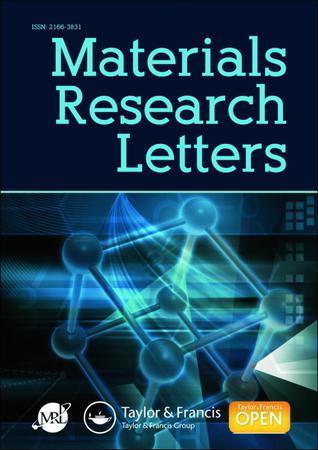Strain glass-induced switch from transformation plasticity to reversible superelasticity in Ti-Zr-Ni-Cu alloys
IF 7.9
1区 材料科学
Q1 MATERIALS SCIENCE, MULTIDISCIPLINARY
引用次数: 0
Abstract
Reversibility of phase transformation, a basic requirement for functional properties of shape memory alloys, such as superelasticity, is severely affected by plastic deformation. Here, strain glass has been utilized to improve the reversibility of phase transformation. The incorporation of Al into Ti-Zr-Ni-Cu induces strain glass and endows the alloy with reversible phase transformation and thus ideal superelasticity. In situ x-ray diffraction and dynamic mechanical experiments were utilized to verify the mechanism for the conversion from transformation plasticity to superelasticity. This work provides a new way to improve the reversibility of phase transformation and expands the practical implications of strain glass.应变玻璃诱导Ti-Zr-Ni-Cu合金从相变塑性到可逆超弹性的转换
相变的可逆性是形状记忆合金超弹性等功能性能的基本要求,塑性变形严重影响相变的可逆性。在这里,应变玻璃被用来提高相变的可逆性。Al在Ti-Zr-Ni-Cu中的掺入引起应变玻璃,使合金具有可逆相变,从而具有理想的超弹性。利用原位x射线衍射和动态力学实验验证了相变塑性向超弹性转变的机理。本工作为提高相变可逆性提供了一条新的途径,拓展了应变玻璃的实际应用。
本文章由计算机程序翻译,如有差异,请以英文原文为准。
求助全文
约1分钟内获得全文
求助全文
来源期刊

Materials Research Letters
Materials Science-General Materials Science
CiteScore
12.10
自引率
3.60%
发文量
98
审稿时长
3.3 months
期刊介绍:
Materials Research Letters is a high impact, open access journal that focuses on the engineering and technology of materials, materials physics and chemistry, and novel and emergent materials. It supports the materials research community by publishing original and compelling research work. The journal provides fast communications on cutting-edge materials research findings, with a primary focus on advanced metallic materials and physical metallurgy. It also considers other materials such as intermetallics, ceramics, and nanocomposites. Materials Research Letters publishes papers with significant breakthroughs in materials science, including research on unprecedented mechanical and functional properties, mechanisms for processing and formation of novel microstructures (including nanostructures, heterostructures, and hierarchical structures), and the mechanisms, physics, and chemistry responsible for the observed mechanical and functional behaviors of advanced materials. The journal accepts original research articles, original letters, perspective pieces presenting provocative and visionary opinions and views, and brief overviews of critical issues.
 求助内容:
求助内容: 应助结果提醒方式:
应助结果提醒方式:


